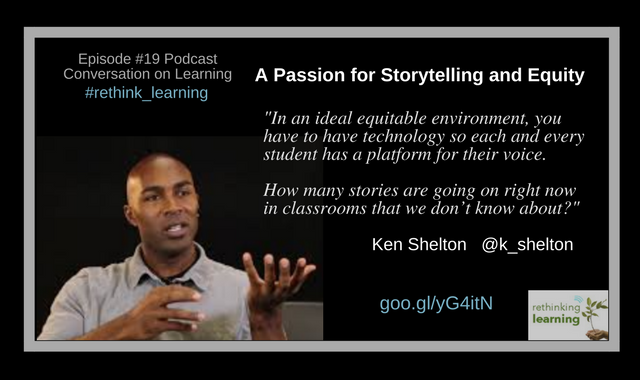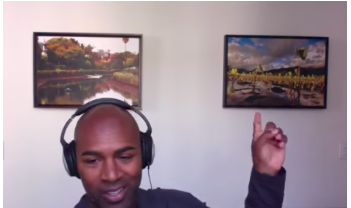Ken Shelton has been an educator for over 14 years and holds an M.A. in Education in Educational Technology as well as New Media Design and Production. Ken regularly gives keynotes, presentations, and leads workshops, many of which are hands-on, covering a wide variety of Educational Technology, Creative Expression, Visual Storytelling, and Instructional Design topics. Ken is currently the Global Keynote Specialist and Educational Technology Strategist for the EdTechTeam.

Podcast: Play in new window | Download

I am very fortunate to have known Ken for many years and to call him my friend. We even have a collection of selfies over multiple years at ISTE so I have to include at least one here. I always attend his sessions because he keeps coming up with new and exciting ideas that I need to learn especially about visuals, storytelling, and equity. Below are excerpts from the podcast.
Can you share a little about yourself and your background?
I grew up and live in Los Angeles. I went to college at UCLA. Growing up in LA has exposed me to several things. I played sports in college and also learned how to surf in my teens. I spent a number of years in the acting and modeling industries. That, in addition to my athletic background, supported a lot of opportunities that shaped how I am now. I started working in education early on as a substitute teacher back when I was in between jobs whether it was a commercial or a modeling job. I recognized that education was an important component of my life. I came from a family of educators. My father was the chief business officer and assistant superintendent for the Los Angeles County Office of Education. He also was at the Santa Clara County Office of Ed and Solano County as well. One of my grandfathers and my maternal grandmother were educators. We have a long history of educators because of the importance of education was instilled in my family on both sides many generations ago. My great grandfather made sure all of his nine children went through school to college.
When I was in high school, one of the things I wanted to do when I grew up was not only to play professional football but after that, I wanted to teach and coach football in high school. I knew I needed to get the credential and then eventually the master’s degree. The doctorate was put on hold, but I’ve been encouraged by a number of folks recently to get into a program.
(Ted Talk) Using the past https://youtu.be/ORsevBbNFwE
I have three girls. I want my girls to have the opportunities I had so they can be diligent and committed to performing well in an educational setting. My oldest is Alice (17), Kennedy (11), and Kyana (9).
Why are you so passionate about educational technology?
When technology is utilized with the appropriate degree of access, that can be a significant pillar in the bridging of an achievement gap or equitable divide. If you take the socio-economic status at a Title I school versus a school that has a 10 million dollar endowment most students in either situation have access to some technology like a Chromebook, and that bridges the gap. The Internet is free and open. You can’t access things on the Internet based on your economic status. For me, a big part of that was looking at how does technology provides transformative learning experiences for teachers and students. How can we capitalize those experiences to allow students and teachers to do things that if it wasn’t for the technology they wouldn’t be able to do?
When I used to teach history, there were a number of glaring omissions in the social studies textbooks. Now, if you have access to the Internet, you can fill those gaps or you can vet the breadth and quality of the information in the textbook. I would love to see school districts take the thousands of dollars spent on textbooks and use that to acquire technology and provide the teachers and students with the right type of support in using that technology. I personally think that textbooks, as far as a primary source of information delivery are obsolete. Take any content area and now you can have access to primary sources and even have real discussions with an author of a book they’re reading. You can’t get that from a textbook. If you don’t have access to technology or don’t use it in an appropriate capacity, you don’t have the ability to connect with authors or discover primary sources. Consider a kindergartener who uses technology and even teaches another child how to use it. Think of the layers of what they are doing and go deeper than that by
(1) they are learning deeper communication skills and
(2) a collaborative growth environment by learning together how we learn together.
My passion is primarily along the lines that you can bridge the achievement and equitable gap and what you can do with technology to bridge that gap.
Let’s talk about data and how educational companies use that data.
It is known that companies curate user data. I don’t have a problem with that as long as it is used in the capacity to improve an existing product, not for selling demographics. Google has the data of who performs what during searches to use to target ads. I know people have an issue with that, but I’ve reminded them that’s basically how the Neilsen Rating system worked back when I was a teenager. They use the demographics of who was watching particular programs on prime time television and then they can sell ad space to promote those products to a target audience. I caution educators not to digitize their lessons. You need to use technology in an appropriate and effective manner. The other side to it is savvy businesses can have conversations with students and teachers to look at how to design a platform or an experience that enhances something you are already doing or can be transformative in what you are doing. That means they are taking that information and data and putting it to good use.
(Ted Talk) Danger of Data: https://youtu.be/c_fI_z7K-dw
I love your visual storytelling and digital storytelling session. Why do visuals and stories matter?
The science is already out that we are wired for storytelling. I love sharing it with other educators who either are speakers or have an interest in becoming speakers. Conversations that we have with our friends and family are essentially nothing more than a series of storytelling. There is a storytelling component that has existed for thousands of years. The visual side of it for me is that visuals have a way of being universally communicable. In one presentation I do on visual storytelling and visual literacy, I take the audience through a series of icons and asks them what is being communicated through these icons? 95 out of 100 will identify an icon communicating the same thing especially one recognized globally. This is an example of an icon I talk about in the session:

The visual aspect is two-fold. One is universally communicable and accessible. Two there are so many layers that are compelling images that we look at. You have to do a detailed and in-depth analysis of the image. Who is the author or artist? What were the time when it was produced and the context of it being produced? Why is that visual representation one that they selected to distribute? Asking these questions makes us more observant of things. Especially now with kids posting so fast on sites like Snapchat or Instagram to capture a moment that could be the speck of what could be a bigger picture and not looking at what’s going on around them. Visuals are a universally communicable and accessible way of storytelling. Just like the saying “A picture is worth 1,000 words,” we can take one medium, share it, and essentially tell a 1,000-word story. One of the pictures on the wall behind me tells my story is one of my favorite places on the island of Kauai.

How do you create learning environments for sustainability, equity, and access?
Essentially what I looked at is multitiered. I juxtaposed the difference between equity and equality. I looked at the system as a whole especially in larger districts with the emphasis on student stratification. For example, you have a school that offers honors and AP classes, regular classes, and remedial classes. I have seen the pattern and trends in the research where there is a disproportionate percentage of students along with a race and socioeconomic status that are generally steered toward the remedial classes. When you think about equitability and access, there is the social-economic and geographic component. Equitable access is a challenge in urban and rural areas. How many learning spaces exist right now where the conversations and learning opportunities are severely limited or skewed because of the lack of accessibility and diverse representation?
Think about what’s going on right now in a society where awareness of social injustices is coming back to the forefront. For some of us, it’s always been there. If we think of the conversations that teachers should be having with their kids and adults should have with other adults, I’d like to see opportunities for schools and teachers to provide more students with accessibility so they can be a part of those learning experiences and those conversations. We can build a degree of understanding, of awareness, and empathy in everybody. Every time you tell a child that they are no good either through omission or commission possibly by telling them they cannot take AP classes, how much human capital have we lost? There was a school district in New York that looked at that dynamics and recognized that they had to do something different. It took some time for them to do it, but they fazed out all of the lower-tier classes and only had honors and AP classes. The students who needed the additional support received it as additional support, not an intervention or remediation. Words matter. Even when the community was concerned about “those kids” being in those classes, the assistant principal said, “those kids are in OUR school in OUR community, so we need to support ALL kids.” If schools work with African American students, I ask them “what is your discipline policy, and is it skewed against students that look like me?” If it is, then there might be a lack of cultural awareness that what you define as a behavior problem may not necessarily be a problem. In an ideal equitable environment, you have to have technology so each and every student has a platform for their voice. How many stories are going on right now in classrooms that we don’t know?
What do you believe is going to be the next big important thing to share?
Storytelling needs to be more amplified. Make sure your story is appropriately represented and distributed. You tell the story in the capacity that would be proud of that tells the real story and not someone else’s.
 Ken currently holds an M.A. in Education with a specialization in Educational Technology as well as New Media Design and Production. He has worked as an educator for over 14 years and most recently taught technology at the Middle School level. As a part of his active involvement in the Educational Technology community, Ken is an Apple Distinguished Educator and a Google Certified Innovator. Ken was also named to the California State Superintendent of Public Instruction’s Education Technology Task Force. Ken regularly gives keynotes, presentations, and leads workshops, many of which are hands-on, covering a wide variety of Educational Technology, Technology Integration, Creative Expression, Visual Learning, Visual Storytelling, and Instructional Design topics. Ken is currently the Global Keynote Specialist and Educational Technology Strategist, for the EdTechTeam.
Ken currently holds an M.A. in Education with a specialization in Educational Technology as well as New Media Design and Production. He has worked as an educator for over 14 years and most recently taught technology at the Middle School level. As a part of his active involvement in the Educational Technology community, Ken is an Apple Distinguished Educator and a Google Certified Innovator. Ken was also named to the California State Superintendent of Public Instruction’s Education Technology Task Force. Ken regularly gives keynotes, presentations, and leads workshops, many of which are hands-on, covering a wide variety of Educational Technology, Technology Integration, Creative Expression, Visual Learning, Visual Storytelling, and Instructional Design topics. Ken is currently the Global Keynote Specialist and Educational Technology Strategist, for the EdTechTeam.
Ken has had the privilege to speak at many major conferences and events around the world as well as schools and school districts. He brings a worldly breadth of experience knowledge and perspective. Ken also had the privilege to speak at the TEDx Burnsville ED event as well as CRESSTCon16 at UCLA in front of a predominantly Higher Ed audience.
Ken’s Contact Information
Twitter: @k_shelton
Pinterest: http://pinterest.com/kenshelton/
Website: http://kennethshelton.net/
Ken’s Photography site: http://www.kensheltonphoto.com/
****
Interested in checking out more of the Rethinking Learning podcasts and reflections, click on the podcast tab at the top, the logo below, or go to https://barbarabray.net/podcasts/
For more information about Barbara’s book, Define Your WHY, go to this page or click on the image of the book for resources, questions, and links.






